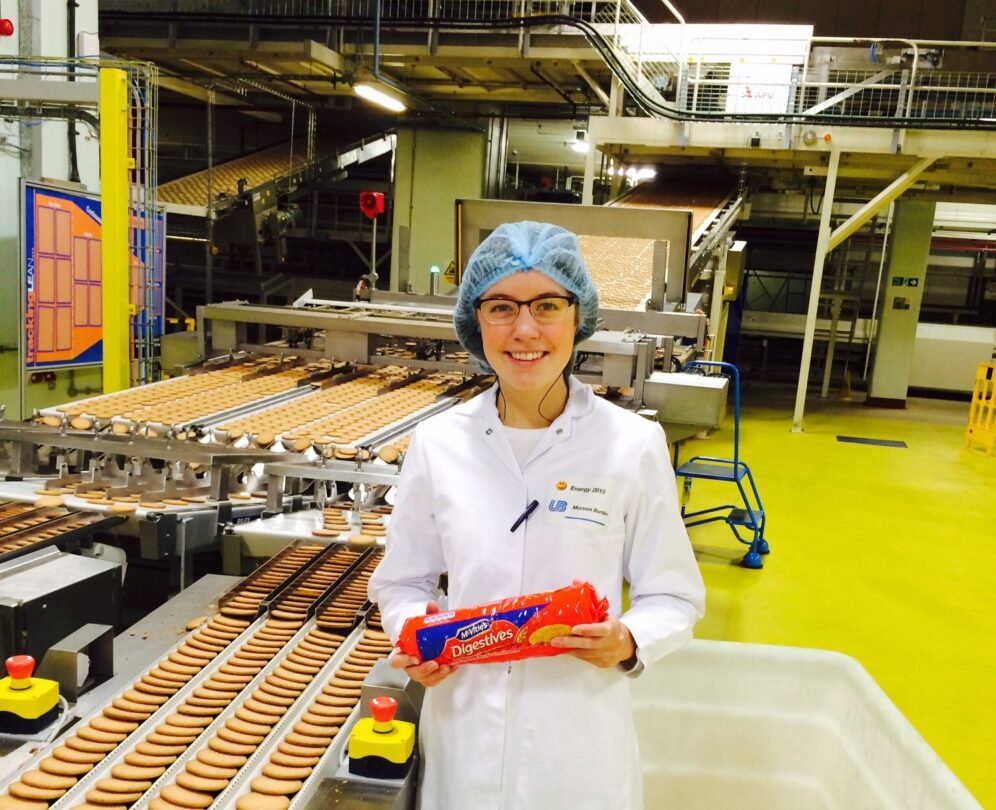Morven Burden: 8 top tips on running an effective manufacturing operation

Running a smooth manufacturing operation can be challenging. With many moving parts to deal with, from logistics and the supply chain to health and safety, managing those operations takes a lot of organisation.
And with the manufacturing industry moving quickly as technology plays an ever greater role, what with artificial intelligence and machine learning making an impact, a shift in how things are done is something business leaders need to be aware of.
One person who appreciates the challenges of running a manufacturing operation smoothly is Morven Burden. A factory manager for snacking and biscuit manufacturer Pladis, she’s based at a site in Romania.
At the age of 27, Morven is the company’s youngest ever factory manager – an accolade that led her to win the Young Manufacturer of the Year award at The Manufacturer MX Awards for 2018, an award proudly sponsored by Sage.
On her award win, she says: “It was a huge sense of achievement. It was a great honour to hear I was selected as the winner. It feels great to have some external recognition for the professional journey I’ve taken so far as well the internal that I’ve received up to now. I love to share my story and passion for manufacturing.”
Morven Burden’s role at Pladis
As the factory manager at Pladis’ only site based in eastern Europe, Morven oversees a team of 250 employees and manages the manufacturing, engineering, logistics, supply chain, food safety, quality, health and safety environment. “We supply to the Balkans and further west as well,” she says.
A love of baking combined with an economics and management degree led to Morven beginning her career at McVitie’s (which is now owned by Pladis) as a team manager, and she has worked her way up in a short space of time.
Having had numerous manufacturing stints, including the management of two production lines in Carlisle, the flagship factory in London, a factory in Leicester where she managed food safety, food quality, environment and security, and head office (“Where I did a role in capability, which looks at what products should be made at what sites”), Morven brings a lot of experience and insight to the table.
Of her current role, she says: “We manufacture a brand called Ulker. How the UK sees McVitie’s is how Turkish people see Ulker. It’s a huge brand over here. There are seven factories in Turkey that make Ulker, then us in Romania that also makes Ulker.”
This article shares Morven’s experiences and offers eight pieces of advice plus key takeaways on how to run an effective manufacturing operation.
Sage Business Cloud X3
Need better insights into your business? Sage Business Cloud X3 provides you with fast, simple and flexible business management, helping you to manage your business and boost your profits.

1. Consider costs and benefits when dealing with challenges
From dealing with the supply chain and equipment problems to overseeing quality control and getting the right team in place to achieve business outcomes, manufacturing challenges can come thick and fast.
Morven says: “All throughout my career so far, there have been challenges to manufacturing to deal with.”
But by putting the right strategies in place, you can overcome those challenges and keep things moving in the right direction.
For Morven, it comes down to costs and benefits.
She says: “I’ve learned that with any problem or challenge you come up against, you balance out the costs and the benefits.
“So whatever the problem, whatever the topic, I always look at what the costs would be, and what the benefits and different options are for the solutions. Then as a team, we review the costs and benefits to come up with the optimal solution.
“Because it’s a different problem every day, I have the same approach to each one of them just to make sure I can come up with the best solution.
“So whether it’s a machine issue or a people issue or a production issue or a distribution issue, it’s always ‘what’s the cost of that problem and what are your options and benefits to solutions?’”
Key takeaway
Consider costs and benefits when dealing with business and manufacturing challenges. Turn to your team, get their feedback, think about the options that are available to you then come up with an optimal solution and put it into practice.
2. Use upgraded software to stay on top of your processes
With Morven’s background working at Pladis’ sites in the UK, she’s seen a side of the business that uses “the same kind of software and the same kind of processes and procedures” across its seven factories. However, things work differently in Romania.
She says: “It uses very different software and processes – and actually very little to be honest. A lot of it is done manually or on Excel.
“I’ve realised how different that operation is but it all depends on that maturity and how far along that site has developed. So it’s been an interesting to see how we can use [software] better to help the site and adopt best practices from the UK.
“This factory is very small compared to others but we can see it ourselves, even as we’ve grown in the past year, that we see the need for upgraded software and more advanced ways of working.”
Key takeaway
Assess your processes and your current software. Off the back of that, consider upgrading to the latest solutions, such as enterprise management software to manage your manufacturing processes. It can help to reduce costs, give you visibility across your manufacturing firm’s many moving parts, reduce risks and ensure compliance.
3. Have the best team to succeed
While using the right software solutions for your business is important, there’s another aspect worth paying close attention to. Your people.
If you want to success in the manufacturing world, having the best team – covering areas such as skill set, knowledge and ability – will help your business go a long way.
Morven says: “The main thing for me is always making sure you have the best people and the best team around you, as everything has to be resolved with the mutual understanding and agreement to get the best solution for everyone and the business.
“For me, it’s all around your team and how you work with the team and how you all work together through issues and challenges.”
Key takeaway
Get the best people into your team and work with them to solve everyday challenges. And work on retaining their services too – developing their skill set and giving them room to grow within your business will go a long way.
Just look at Morven’s career progression, for example.
4. Take a look at the role new technologies will play within manufacturing
Manufacturing is an ever-evolving industry and like the rest of the world, disruptive technologies are changing the landscape. It’s something Morven has been acutely aware of during her time in the industry.
“What’s interesting is that with automation and development, it’s already changed since I’ve been in here, with the number of investments and automations that are coming in. So it will be fascinating to see how that develops,” she says.
“We can see with our own lives how quickly technology is advancing and before we realise there’s a change, it’s already very different to what it was a few years ago.
“And we’re going to see that within manufacturing. As it becomes more common for different automations, it will become cheaper and more accessible for everyone.
“I do think even in my career in manufacturing, things will look very different to what they look like now.”
Key takeaway
Considering the role that newer technologies are playing within manufacturing and how they will change your processes both now and in the future is important.
With artificial intelligence and machine learning making an impact and automation leading to a realigning of priorities, taking stock of these changes and being agile is key.
Four more tips on running an effective manufacturing operation
To conclude this article, Morven shares her four top tips on successfully running a factory and how to deliver positive outcomes within your manufacturing processes.
1. Be people oriented
“To me, the main one is being people oriented. Talk to people from across the businesses, learn from the different sites and different industries, and communicate to your staff as well.
“They need to understand what’s going on from a wider picture rather than just their specific roles in the factories. I’m very big and keen on advocating people on community growth in the factories.”
Key takeaway
Focus on your people as they are your most important asset.
2. Be a problem solver
“We always have to focus on solutions and the speed of that is also critical. So the quicker you can solve problems, and ideally before it’s a problem, the better.
“Also, going back to people, I’m very keen on training people on how they can problem solve, so everyone can contribute to making those improvements.”
Key takeaway
Problem solving doesn’t just have to be for business leaders. Everyone across the company should be able to offer their input on solving issues. And moving quickly and effectively is essential.
3. Be adaptable
“The industry is always changing and evolving. So adopt those changes quickly.”
Key takeaway
With Industry 4.0 and digital transformation starting to make an impact in manufacturing, it’s important to be ready for changes. Manufacturing will look very different in five or ten years. Even in a year or two.
So understanding how those changes will play a role is important. Keep learning and keep moving.
4. You don’t need to know all of the answers
“It was in my first year [at McVitie’s] and the lady on the line said to me: ‘You’re the best manager I’ve ever had because you say you don’t know.’
“I thought that was a bit strange, so I dug a bit deeper to understand what she was meaning and she explained that when they ask me questions, if I don’t know the answers, I say ‘I don’t know’ but I always go away and come back with the real answers.
“She was saying that me being open, honest and consistent – and actually being my natural self – built a lot of trust within the team. So I learned a lot from that because I think that was unusual, especially within a male dominated and manufacturing mindset.
“I learned that by being honest, being yourself, as long as you cared for the people and cared for what they were wanting, that was the best way to approach things.
“So I’ve always followed that from my first year. Being myself, being open and honest with everyone. And so far, it’s helped me get where I am.”
Key takeaway
Manufacturing continues to go through lots of changes and that means you won’t always know the answers. But by surrounding yourself with the right people, you don’t have to.
Work with your people to come up with the solutions to the questions you can’t immediately answer.
Should you upgrade?
This free guide will provide you with four reasons why you should upgrade from your legacy ERP system to a modern enterprise management solution for your business.






Ask the author a question or share your advice